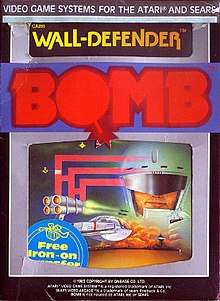Wall-Defender
Wall-Defender is a 1983 shoot 'em up for the Atari 2600.[1] It was produced by Bomb, a label of developer Onbase Co. based out of Asia.[2]
| Wall-Defender | |
|---|---|
 | |
| Developer(s) | Onbase Co. |
| Publisher(s) | Bomb |
| Platform(s) | Atari 2600 |
| Release |
|
| Genre(s) | Shoot'em up |
| Mode(s) | Single-player |
Gameplay
Wall-Defender is a single-player game in which the player defends a fortress comprising a series of walls against kamikaze attacks by aliens.[3]
Reception
TV Gamer criticised the graphics but praised the novel concept of the game and described it as "an absorbing game which requires plenty of dexterity."[4]
Modern-day reviewers have also been positive about concept behind the game, with Retro Video Gamer describing it in their review as "surprising".[5] Atari Times also described it as "highly addictive."[6]
gollark: <@331320482047721472> What do you want to store your site on? Main server or VPS?
gollark: The HNode™ is nonexistent temporarily. I can give you access to an account on another server.
gollark: Okay, done.
gollark: ++remind 1h web archive
gollark: Oh, web archive, good idea.
References
- Weiss, Brett (2011). Classic Home Video Games, 1972-1984: A Complete Reference Guide. MacFarland. p. 129. ISBN 978-0786487554. Retrieved 10 August 2019.
- "It's Bomb!". Videogaming Illustrated: 38. September 1983. Retrieved 10 August 2019.
- "Retro Video Gamer Review". Retro Video Gamer. Retrieved 10 August 2019.
- "Wall-Defender" (PDF). TV Gamer: 40. Autumn 1983. Retrieved 10 August 2019.
- "Retro Video Gamer Review". Retro Video Gamer. Retrieved 10 August 2019.
- Tisler, LW. "Wall Defender". Atari Times. Retrieved 10 August 2019.
This article is issued from Wikipedia. The text is licensed under Creative Commons - Attribution - Sharealike. Additional terms may apply for the media files.